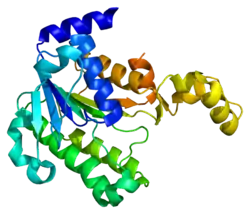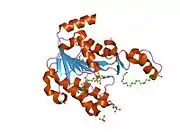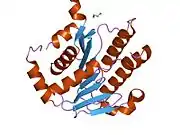| HTATIP2 | |||||||||||||||||||||||||||||||||||||||||||||||||||
|---|---|---|---|---|---|---|---|---|---|---|---|---|---|---|---|---|---|---|---|---|---|---|---|---|---|---|---|---|---|---|---|---|---|---|---|---|---|---|---|---|---|---|---|---|---|---|---|---|---|---|---|
 | |||||||||||||||||||||||||||||||||||||||||||||||||||
| |||||||||||||||||||||||||||||||||||||||||||||||||||
| Identifiers | |||||||||||||||||||||||||||||||||||||||||||||||||||
| Aliases | HTATIP2, CC3, SDR44U1, TIP30, HIV-1 Tat interactive protein 2 | ||||||||||||||||||||||||||||||||||||||||||||||||||
| External IDs | OMIM: 605628 MGI: 1859271 HomoloGene: 4676 GeneCards: HTATIP2 | ||||||||||||||||||||||||||||||||||||||||||||||||||
| |||||||||||||||||||||||||||||||||||||||||||||||||||
| |||||||||||||||||||||||||||||||||||||||||||||||||||
| |||||||||||||||||||||||||||||||||||||||||||||||||||
| |||||||||||||||||||||||||||||||||||||||||||||||||||
| |||||||||||||||||||||||||||||||||||||||||||||||||||
| Wikidata | |||||||||||||||||||||||||||||||||||||||||||||||||||
| |||||||||||||||||||||||||||||||||||||||||||||||||||
Oxidoreductase HTATIP2 is an enzyme that in humans is encoded by the HTATIP2 gene.[5][6][7][8] It may be a metastasis suppressor.
References
- 1 2 3 GRCh38: Ensembl release 89: ENSG00000109854 - Ensembl, May 2017
- 1 2 3 GRCm38: Ensembl release 89: ENSMUSG00000039745 - Ensembl, May 2017
- ↑ "Human PubMed Reference:". National Center for Biotechnology Information, U.S. National Library of Medicine.
- ↑ "Mouse PubMed Reference:". National Center for Biotechnology Information, U.S. National Library of Medicine.
- ↑ Xiao H, Tao Y, Greenblatt J, Roeder RG (Apr 1998). "A cofactor, TIP30, specifically enhances HIV-1 Tat-activated transcription". Proc Natl Acad Sci U S A. 95 (5): 2146–51. Bibcode:1998PNAS...95.2146X. doi:10.1073/pnas.95.5.2146. PMC 19278. PMID 9482853.
- ↑ Shtivelman E (Jun 1997). "A link between metastasis and resistance to apoptosis of variant small cell lung carcinoma". Oncogene. 14 (18): 2167–73. doi:10.1038/sj.onc.1201059. PMID 9174052.
- ↑ Persson B, Kallberg Y, Bray JE, Bruford E, Dellaporta SL, Favia AD, Duarte RG, Jörnvall H, Kavanagh KL, Kedishvili N, Kisiela M, Maser E, Mindnich R, Orchard S, Penning TM, Thornton JM, Adamski J, Oppermann U (Feb 2009). "The SDR (short-chain dehydrogenase/reductase and related enzymes) nomenclature initiative". Chem Biol Interact. 178 (1–3): 94–8. doi:10.1016/j.cbi.2008.10.040. PMC 2896744. PMID 19027726.
- ↑ "Entrez Gene: HTATIP2 HIV-1 Tat interactive protein 2, 30kDa".
Further reading
- Maruyama K, Sugano S (1994). "Oligo-capping: a simple method to replace the cap structure of eukaryotic mRNAs with oligoribonucleotides". Gene. 138 (1–2): 171–4. doi:10.1016/0378-1119(94)90802-8. PMID 8125298.
- Suzuki Y, Yoshitomo-Nakagawa K, Maruyama K, Suyama A, Sugano S (1997). "Construction and characterization of a full length-enriched and a 5'-end-enriched cDNA library". Gene. 200 (1–2): 149–56. doi:10.1016/S0378-1119(97)00411-3. PMID 9373149.
- Baker ME (1999). "TIP30, a cofactor for HIV-1 Tat-activated transcription, is homologous to short-chain dehydrogenases/reductases". Curr. Biol. 9 (13): R471. doi:10.1016/S0960-9822(99)80297-8. PMID 10395547. S2CID 7740085.
- Whitman S, Wang X, Shalaby R, Shtivelman E (2000). "Alternatively spliced products CC3 and TC3 have opposing effects on apoptosis". Mol. Cell. Biol. 20 (2): 583–93. doi:10.1128/MCB.20.2.583-593.2000. PMC 85138. PMID 10611237.
- Xiao H, Palhan V, Yang Y, Roeder RG (2000). "TIP30 has an intrinsic kinase activity required for up-regulation of a subset of apoptotic genes". EMBO J. 19 (5): 956–63. doi:10.1093/emboj/19.5.956. PMC 305635. PMID 10698937.
- Baker ME, Yan L, Pear MR (2000). "Three-dimensional model of human TIP30, a coactivator for HIV-1 Tat-activated transcription, and CC3, a protein associated with metastasis suppression". Cell. Mol. Life Sci. 57 (5): 851–8. doi:10.1007/s000180050047. PMID 10892349. S2CID 25141732.
- NicAmhlaoibh R, Shtivelman E (2001). "Metastasis suppressor CC3 inhibits angiogenic properties of tumor cells in vitro". Oncogene. 20 (2): 270–5. doi:10.1038/sj.onc.1204075. PMID 11313954.
- Ito M, Jiang C, Krumm K, Zhang X, Pecha J, Zhao J, Guo Y, Roeder RG, Xiao H (2004). "TIP30 deficiency increases susceptibility to tumorigenesis". Cancer Res. 63 (24): 8763–7. PMID 14695192.
- Jiang C, Ito M, Piening V, Bruck K, Roeder RG, Xiao H (2004). "TIP30 interacts with an estrogen receptor alpha-interacting coactivator CIA and regulates c-myc transcription". J. Biol. Chem. 279 (26): 27781–9. doi:10.1074/jbc.M401809200. PMID 15073177.
- Tsutsumi S, Kamata N, Vokes TJ, Maruoka Y, Nakakuki K, Enomoto S, Omura K, Amagasa T, Nagayama M, Saito-Ohara F, Inazawa J, Moritani M, Yamaoka T, Inoue H, Itakura M (2004). "The novel gene encoding a putative transmembrane protein is mutated in gnathodiaphyseal dysplasia (GDD)". Am. J. Hum. Genet. 74 (6): 1255–61. doi:10.1086/421527. PMC 1182089. PMID 15124103.
- King FW, Shtivelman E (2004). "Inhibition of nuclear import by the proapoptotic protein CC3". Mol. Cell. Biol. 24 (16): 7091–101. doi:10.1128/MCB.24.16.7091-7101.2004. PMC 479715. PMID 15282309.
- Suzuki Y, Yamashita R, Shirota M, Sakakibara Y, Chiba J, Mizushima-Sugano J, Nakai K, Sugano S (2004). "Sequence comparison of human and mouse genes reveals a homologous block structure in the promoter regions". Genome Res. 14 (9): 1711–8. doi:10.1101/gr.2435604. PMC 515316. PMID 15342556.
- Sun L, Feng S, Reséndiz JC, Lu X, Durante W, Kroll MH (2005). "Role of the Pyk2-MAP kinase-cPLA2 signaling pathway in shear-dependent platelet aggregation". Annals of Biomedical Engineering. 32 (9): 1193–201. doi:10.1114/B:ABME.0000039353.97347.28. PMID 15493507. S2CID 31410967.
- Shi M, Zhang X, Wang P, Zhang HW, Zhang BH, Wu MC (2005). "TIP30 regulates apoptosis-related genes in its apoptotic signal transduction pathway". World J. Gastroenterol. 11 (2): 221–7. doi:10.3748/wjg.v11.i2.221. PMC 4205406. PMID 15633220.
- El Omari K, Bird LE, Nichols CE, Ren J, Stammers DK (2005). "Crystal structure of CC3 (TIP30): implications for its role as a tumor suppressor". J. Biol. Chem. 280 (18): 18229–36. doi:10.1074/jbc.M501113200. PMID 15728189.
- Caldwell RL, Lane KB, Shepherd VL (2006). "HIV-1 Tat interaction with cyclin T1 represses mannose receptor and the bone morphogenetic protein receptor-2 transcription". Arch. Biochem. Biophys. 449 (1–2): 27–33. doi:10.1016/j.abb.2006.02.020. PMID 16615932.
This article is issued from Wikipedia. The text is licensed under Creative Commons - Attribution - Sharealike. Additional terms may apply for the media files.







